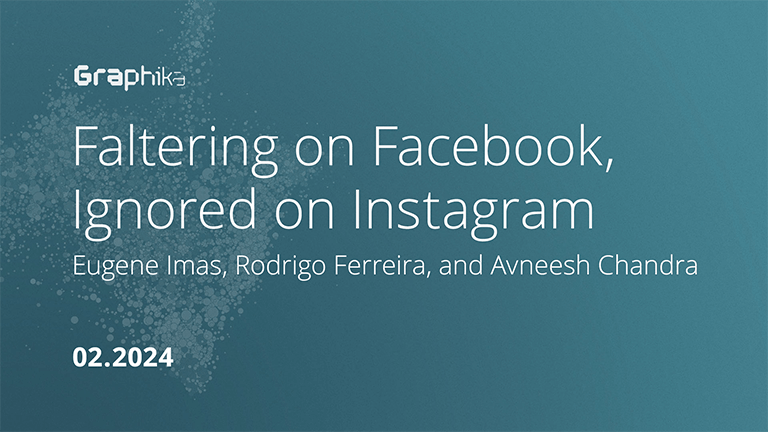

Graphika Report
Wednesday February 14, 2024
Faltering on Facebook, Ignored on Instagram
Eugene Imas, Rodrigo Ferreira, and Avneesh Chandra
Download NowExamining the Activities of Russian State-Controlled Media on Meta Platforms Two Years After the Invasion of Ukraine
This February marks two years since the Russian invasion of Ukraine and a decade since “little green men” first appeared in Crimea, paving the way for Moscow’s illegal annexation of the peninsula. The events of February 2022 triggered the largest military conflict in Europe since World War II, killing or injuring hundreds of thousands of people and prompting social media platforms to take unprecedented actions to curtail the reach of Russian state-controlled media. Over the last two years, Graphika has worked with industry partners at Meta to detect, track, and expose overt and covert Russian influence operations on its platforms.
Last year, our analysis of the activities of Russian state media outlets on Facebook and Instagram found that restrictions Meta introduced on these actors in February - March 2022 led to a sharp decline in posting and engagement volumes. By Aug. 24, 2022, six months after the invasion began, posting volumes were down 43%, and engagement levels had fallen 80% compared to the same day a year earlier. Two years on from the invasion, we repeated our analysis to assess whether those trends have persisted, and more closely examine the narratives and content promoted by Russian state media since the beginning of the war.
Using data provided by CrowdTangle, we analyzed the posting volumes and engagement levels for a set of 298 Facebook pages and Instagram accounts labeled as “Russian state-controlled media” by Meta that were active between Feb. 1, 2022, and Jan. 31, 2024. The set includes prominent outlets, such as RT and Sputnik, as well as lesser-known digital content producers with reported ties to the Russian state. Our analysis found that reduced posting and engagement levels have continued or fallen further since March 2022. As of Jan. 31 this year, posting volumes were down 55% and engagement levels had fallen 94% compared to the same day two years earlier. More than half of all Russian state media assets had stopped posting altogether.
Working with the same set of accounts, we also reviewed and labeled the narratives advanced by Russian state media outlets on Meta platforms during three one-month observation periods: February 2022, February 2023, and January 2024. Taken together, these data sets provide a series of snapshots of the content posted by Russian state media outlets at key points over the last two years.
A comparative analysis of the datasets shows that what started as a broadly aligned set of narratives focused on the war in Ukraine and COVID-19 has diversified over time, as different outlets pursued a wider range of topics reflecting their individual audiences. Coverage of the war in Ukraine has decreased and evolved since the start of the invasion, becoming increasingly intertwined with overarching criticism of the West, and attention has shifted to the Israel-Hamas conflict and events in the Middle East. The accounts have also stepped up their focus on non-political infotainment content and promotional narratives about Russia, such as local human interest stories or Russian Soviet nostalgia.
Download Now